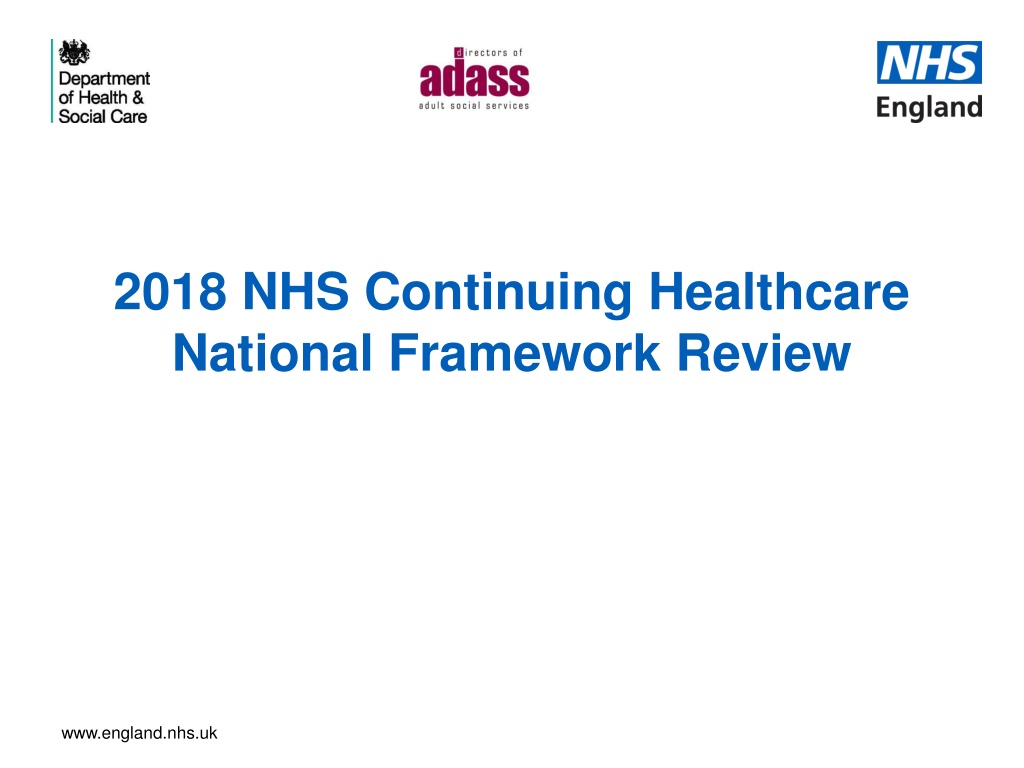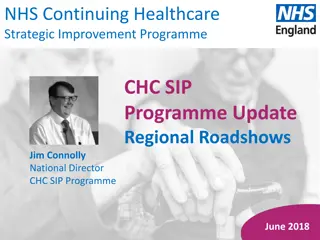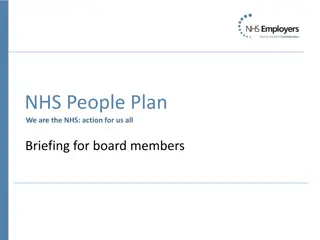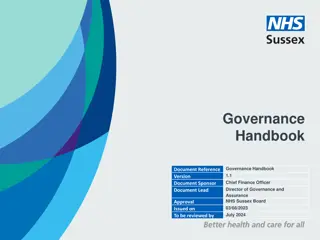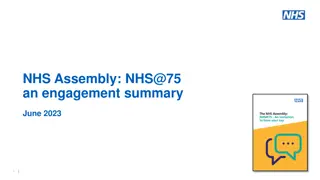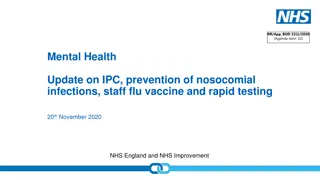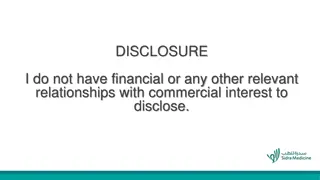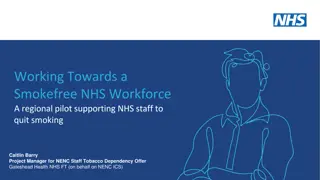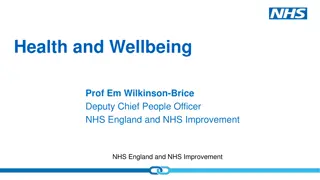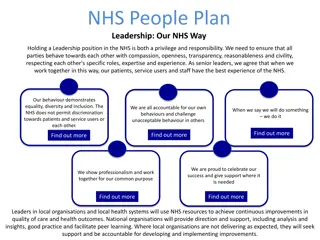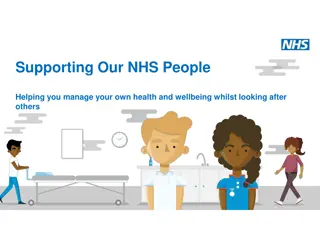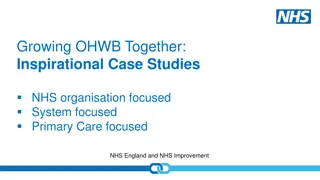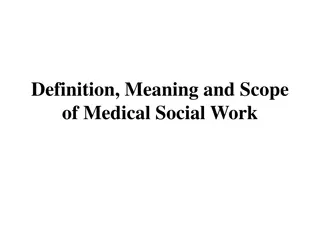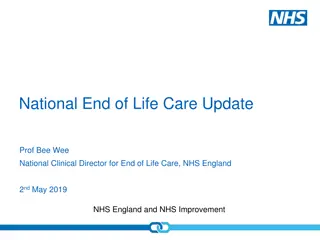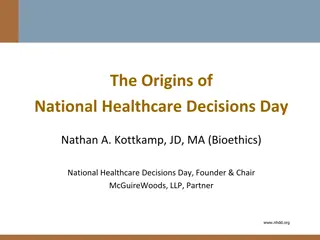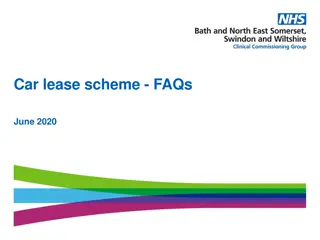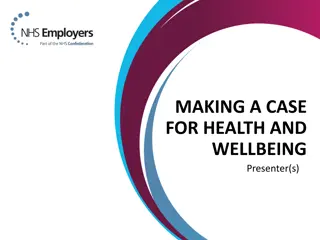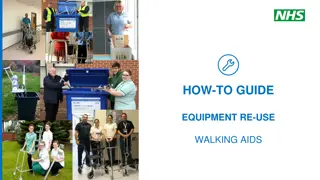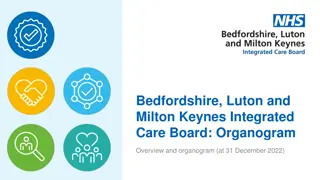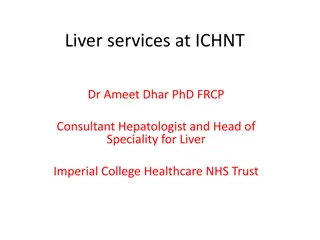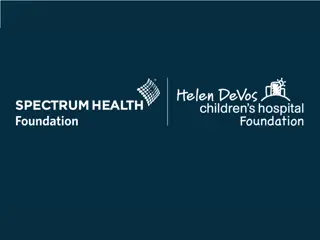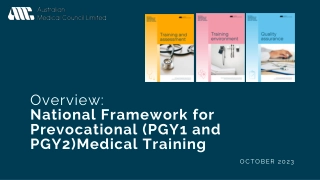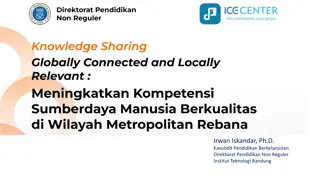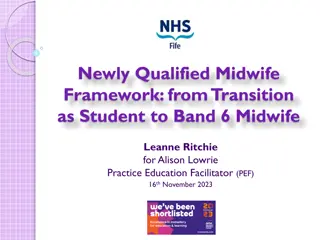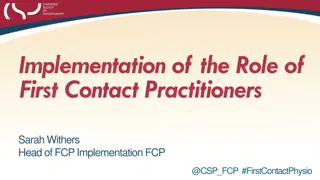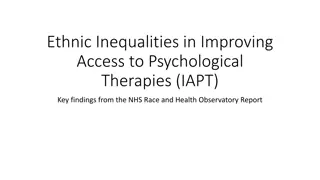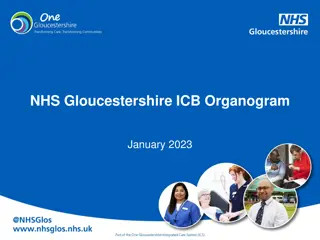Review of 2018 NHS Continuing Healthcare National Framework
The 2018 NHS Continuing Healthcare National Framework review focuses on improving care for vulnerable individuals, enhancing the individual experience, optimizing health and social care staff resources, and ensuring consistency in assessment and decision-making processes. Key changes include new structure and style for clarity, reflecting legislative changes such as the Care Act 2014, and providing additional policy clarity. The Framework emphasizes maintaining eligibility criteria and engagement processes while incorporating new elements like the Checklist threshold and updated tools.
Download Presentation

Please find below an Image/Link to download the presentation.
The content on the website is provided AS IS for your information and personal use only. It may not be sold, licensed, or shared on other websites without obtaining consent from the author. Download presentation by click this link. If you encounter any issues during the download, it is possible that the publisher has removed the file from their server.
E N D
Presentation Transcript
2018 NHS Continuing Healthcare National Framework Review www.england.nhs.uk
Strategic Context Care for vulnerable individuals Improving the individual experience Making the best use of our health and social care staff Ensuring consistency of assessment and decision- making www.england.nhs.uk 2
Process and Parameters No change in eligibility criteria for, or access to, CHC Long structured engagement process NHS England, CCGs, NHS Clinical Commissioners, LAs, patient representative groups, ADASS & LGA, etc. Mandate not to change underlying principles or criteria for NHS Continuing Healthcare (CHC) - very limited scope for regulatory change Policy area where change has not been possible: o Checklist threshold Co-production of updated Framework and Tools with DHSC, NHS England and ADASS The new Framework will look and feel quite different so we all need to read it with fresh eyes and decide what we might need to do differently in order to implement it www.england.nhs.uk
What are the key changes in the revised National Framework for NHS Continuing Healthcare and NHS-funded Nursing Care? 1. A new structure and style to provide greater clarity to individuals and staff [next slide] 2. Changes to reflect introduction of Care Act 2014, and other legislative/policy developments since 2012 [slide 6] 3. Additional clarity to a number of policy areas [slide 7] www.england.nhs.uk 4
New Structure and Style The overall layout has been amended to provide greater clarity to individuals and staff. The revision has taken the flow of the process into account so that the contents are in clearer sections Key policy parts of previous Practice Guidance moved into main Framework Structure of Practice Guidance revised to fit with structure of Framework as have the annexes, and associated tools (Checklist, Decision Support Tool (DST) and Fast Track Pathway Tool) www.england.nhs.uk 5
Legislative Changes The National Framework has been revised in 2018 to reflect legislative changes since the publication of the 2012 version, primarily to reflect the implementation of the Care Act 2014, e.g. In relation to: o the limits of LA responsibility (43) o what counts as a social care need (51-2) o the duties of local authorities and NHS bodies (21-30) [slides 14,15 & 16] o Interactions e.g. care and support assessments The consent section has been updated to align with the GDPR whilst retaining the requirement for explicit consent. Clarifying the definition of Registered Nursing input The language has been strengthened around the interaction with Section 117 www.england.nhs.uk 6
Key areas of Policy Clarification Areas we have revised in the 2018 National Framework When and where to assess eligibility for NHS CHC [next slide] When not to screen/checklist [slide 10 and 11] Provision of dedicated sections for: [slide 12] o Primary Health Need o Roles of CCGs, NHS England and Local Authorities o NHS-funded Nursing Care (NHS FNC) o Inter-agency disputes o Well-managed Needs o The Fast Track Pathway Purpose of 3 and 12 month reviews [slide 17] Principles for Local Resolution [slide 18] Issues being taken forward outside of the 2018 National Framework -Workforce and training -Timelines for local resolution and independent review (being re-considered) Issues not taken forward for the 2018 National Framework -Top-ups -Rolling cut off for Previously unassessed periods of care. www.england.nhs.uk 7
When and where to assess eligibility for NHS CHC Strong message assess CHC at right time and in right place. (consistent with QP measure, less than 15% of all full CHC assessments in acute setting) Additional guidance relating to the interaction between CHC and hospital discharge (109-115) CCGs and partner organisations should have the right processes/pathways in place for individuals who may have a need for CHC need to develop local protocols to support this (110) Some examples of processes and pathways given these are to support more accurate assessment of need and reduce unnecessary stays in hospital. [next slide] www.england.nhs.uk 8
Examples of hospital discharge pathways a) b) c) Interim NHS-funded services on discharge before Checklisting -ve Checklist in hospital refer to LA if needed +ve Checklist in hospital NHS funded services after discharge until full CHC assessment done (or no longer necessary) +ve Checklist followed (exceptionally) by full CHC assessment in acute setting (<15%) Agreement by all parties that individual can safely return to existing unchanged package/placement and Checklist is undertaken within 6 weeks if needed d) e) www.england.nhs.uk
When not to screen/Checklist 1 of 2 In addition to the section on when and where to assess eligibility for NHS CHC, further clarity is given on when it is not necessary to complete a checklist: It is clear to practitioners working in the health and care system that there is no need for NHS Continuing Healthcare at this point in time. Where appropriate / relevant this decision and its reasons should be recorded. If there is doubt between practitioners a Checklist should be undertaken. The individual has short-term health care needs or is recovering from a temporary condition and has not yet reached their optimum potential (if there is doubt between practitioners about the short-term nature of the needs it may be necessary to complete a Checklist). See paragraphs 109-117 for how NHS Continuing Healthcare may interact with hospital discharge. www.england.nhs.uk 10
When not to screen/Checklist 2 of 2 It has been agreed by the CCG that the individual should be referred directly for full assessment of eligibility for NHS Continuing Healthcare. The individual has a rapidly deteriorating condition and may be entering a terminal phase in these situations the Fast Track Pathway Tool should be used instead of the Checklist. An individual is receiving services under Section 117 of the Mental Health Act that are meeting all of their assessed needs. It has previously been decided that the individual is not eligible for NHS Continuing Healthcare and it is clear that there has been no change in needs. This section is intended to encourage screening at the right time and location in order to reduce unnecessary assessment processes. www.england.nhs.uk 11
Provision of Dedicated Sections for: Primary Health Need - bringing together the definition and explanation of PHN into one section early in the Framework (54-66) Roles of CCGs, NHSE and Local Authorities whilst recognising strong system leadership is required for the delivery of NHS CHC, this section clearly outlines organisational roles and responsibilities [slides 14-16] NHS-funded Nursing Care (NHS FNC) clearer detail is provided about what this incorporates including how it is funded and reviewed (248) Inter-agency Disputes greater clarity is given about duties of CCGs and Local Authorities within their agreed local dispute resolution process. This covers principles required and what sort of issues it should address. (208-212) Well-managed Needs this brings much of the information together to support consistency of understanding (142-146) The Fast Track Pathway - this brings all the information together to support consistency of understanding; it clarifies how the tool should be completed, CCG responsibilities on receipt of a completed Fast Track tool and the review process (217-245) www.england.nhs.uk 12
The Associated Tools The Associated Tools have been reviewed to align with the revised National Framework Re-ordering of domains in Checklist and DST Minor changes to some wording in the descriptors Slightly different layout for Checklist, with inclusion of when not to screen Alignment of Tool user notes with Framework wording Fast Track responsibilities Work is ongoing to: Publish the revised 2018 NHS-funded Nursing Care Practice Guidance Publish the revised 2018 Easy Read guide for Learning Disabilities Publish the revised 2018 Public Information Leaflet Update the Care Act guidance to provide further clarity on the interaction between Assessment Notices, hospital discharge, and consideration of CHC www.england.nhs.uk 13
Roles of LAs Roles and responsibilities of the local authority, in summary, include: Where it appears that a person may be eligible for CHC, the local authority must refer the individual to the relevant CCG. a. There are specific requirements for local authorities to cooperate and work in partnership with CCGs in a number of key areas. b. Local authorities must, as far as is reasonably practicable, provide advice and assistance when consulted by the CCG in relation to an assessment of eligibility for CHC c. A local authority must, when requested to do so by the CCG, co-operate with the CCG in arranging for a person or persons to participate in a multidisciplinary team. Local authorities should: respond within a reasonable timeframe when consulted by a CCG prior to an eligibility decision being made respond within a reasonable timeframe to requests for information when the CCG has received a referral for CHC. d. It is also good practice for local authorities to work jointly with CCGs in the planning and commissioning of care for individuals eligible for CHC wherever appropriate, sharing expertise and local knowledge e. LAs must nominate and make available people to sit on IRPs where requested to do so by NHS England and as soon as reasonably practicable (paras 25-30) www.england.nhs.uk 14
Roles of NHS England a) Strategic leadership in relation to CHC, including organisational and workforce development b) Holding CCGs accountable for CHC delivery - engaging with them to ensure that they discharge their functions. c) Ensuring that local systems operate effectively and deliver improved performance. d) Appointing persons to act as chairs of independent review panels (IRPs) and establishing a list of IRP members drawn from local authorities and CCGs, in accordance with Standing Rules. e) In some limited circumstances, NHS England may also have commissioning responsibility for some individuals who are either prisoners, or serving military personnel and their families. (22-24) www.england.nhs.uk
Roles of CCGs CCGs are responsible and accountable for system leadership for CHC within their local health and social care economy,. In summary, their responsibilities include: a) ensuring delivery of, and compliance with, the National Framework b) promoting awareness of CHC c) governance for CHC eligibility processes and for commissioning CHC packages d) ensuring that assessment mechanisms are in place across care pathways e) making decisions on eligibility for CHC f) identifying and acting on issues arising in the provision of CHC g) commissioning arrangements, both on a strategic and an individual basis h) recording assessments and their outcomes, and the costs of CHC packages i) Implementing and maintaining good practice j) ensuring that quality standards are met and sustained k) providing suitably skilled professionals to be members of IRPs l) ensuring (with LA) that training is available for practitioners m) having clear CHC arrangements in place with other orgs (e.g. Foundation Trusts) (Para 21) www.england.nhs.uk 16
Purpose and frequency of 3 and 12 month reviews Confirmed that an initial 3 month review is required followed by further reviews taking place on at least an annual basis. The primary focus of reviews is clarified as checking whether the care plan or arrangements remain appropriate to meet the individual s needs. Reassessment of eligibility is only to take place where there is clear evidence of a change in needs to such an extent that it may impact upon the individual s eligibility for CHC. The intention is to reduce unnecessary reassessments and details on the responsibilities are set out in a flow chart. (paras 181-191) www.england.nhs.uk 17
Principles for Local Resolution Where an individual or their representative asks the CCG to review the eligibility decision, this should be addressed through the local resolution procedure, which is normally expected to resolve the matter. In summary (para 195): start with informal but meaningful 2 way discussion formal meeting if required with decision on next steps after formal meeting either uphold or change original decision if decision stands individual at least has clear explanation where individuals wish to move straight to a formal meeting this should be considered can prioritise resolution for those currently receiving care www.england.nhs.uk 18
In summary Read and implement the updated Framework: https://www.gov.uk/government/publications/national- framework-for-nhs-continuing-healthcare-and-nhs-funded- nursing-care Ask yourself what do I need to do differently? Work together within and across organisations to ensure fair and consistent access to CHC Work together to use time and resources as effectively as possible Support frontline staff Work together to improve the experience of individuals being assessed for CHC and also those in receipt of CHC www.england.nhs.uk 19
Questions www.england.nhs.uk 20
Table Discussion What are the main implications of the updated Framework and Tools? What needs to be done differently? By whom? What help is needed and from whom? What can you share? What does your system do well that others might learn from? www.england.nhs.uk 21
Action Planning 1. what does your local health and social care system need to do to implement the updated Framework? 2. what does your own organisation need to do? 3. what are you going to do? www.england.nhs.uk 22
